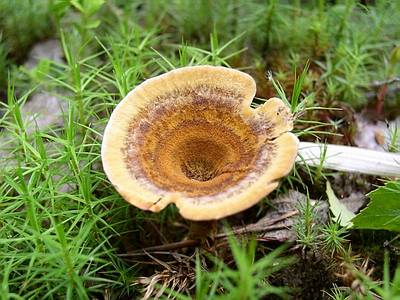Sukhlyanka biennial (Coltricia perennis)
- Division: Basidiomycota (Basidiomycetes)
- Subdivision: Agaricomycotina (Agaricomycetes)
- Class: Agaricomycetes (Agaricomycetes)
- Subclass: Incertae sedis (of uncertain position)
- Order: Hymenochaetales (Hymenochetes)
- Family: Hymenochaetaceae (Hymenochetes)
- Genus: Coltricia (Coltricia)
- Type: Coltricia perennis (Sukhlyanka biennial)
 Description:
Description:
Cap 3-8 (10) cm in diameter, rounded, funnel-shaped, depressed, sometimes almost flat, with a thin, often uneven and wavy edge, finely fleshy, sometimes radially finely wrinkled, first matte, fine velvety, then glabrous, yellow-ocher, ocher, yellow -brown, light brown, sometimes with a gray-brown middle, with noticeable concentric zones of light brown tones, with a light narrow edge, in wet weather – dark, dark brown with a light edge. It happens with fused neighboring hats and with plants and blades of grass sprouting through it.
The tubular layer is slightly descending, reaching a velvety stem, finely porous, irregularly shaped pores, with an uneven, split edge, brownish, then brown-brown, dark brown, lighter along the edge.
Leg 1-3 cm long and about 0,5 cm in diameter, central, narrowed, often with a nodule, with a clearly defined border at the top, velvety, matte, brown, brownish.
The pulp is thin, leathery-fibrous, brown, rusty in color.
Spread:
Grows from early July to late autumn in coniferous and mixed forests, often on sandy soils, in fires, in groups, not uncommon.
The similarity:
It is similar to Onnia tomentosa, from which it differs in thinner flesh, darker brownish, slightly descending hymenophore.
Evaluation:
inedible









